Information on Service 'Download guard for hsoy dump'
![[Use this service from your browser]](/static/img/usesvcbutton.png)
Further access options are discussed below
For a list of all services and tables belonging to this service's
resource, see Information on resource 'The HSOY Catalog'
Service Documentation
The HSOY catalog is a common reduction of PPMXL and Gaia DR1. It
essentially applies the technique discussed in
2010AJ....139.2440R, with PPMXL filling the role of USNO-B
and Gaia DR1 filling the role of 2MASS. The concrete implementation
is fairly different, though. Interested users are referred to
the HSOY resource descriptor (this is a DaCHS file, but actual
processing is written in SQL), in particular the add_gaia element.
Access Options
Like Gaia DR1, HSOY is primarily published through a TAP service; the
primary site is ivo://org.gavo.dc/tap with the access URL
http://dc.g-vo.org/tap.
For simple tasks, there is an IVOA cone search service at
http://dc.g-vo.org/hsoy/q/q/scs.xml (browser interface at
http://dc.g-vo.org/hsoy/q/q/form).
If you insist, the catalog content can also be downloaded in the
form of an xz-compressed Postgres ASCII dump. This is a 40 GB download,
and you'll probably spend more time making this useful for you than you'd
spend learning ADQL and just using TAP. If you do pull the dump,
do, you will find the the metadata (including the column sequence) at
http://dc.g-vo.org/tableinfo/hsoy.main. To get this a bit more
machine-readably, run SELECT TOP 1 * FROM hsoy.main on our
TAP service.
Statistics
The HSOY catalog contains 583'001'683 objects; this is significantly less
than both the roughly 9e8 of PPMXL and the roughly 1.2e9 of Gaia DR1. The
bulk of the objects missing in HSOY versus PPMXL should be non-stellar
detections and failed matches PPMXL inherited from USNO-B1, but of course
the inhomogeneous coverage of Gaia DR1 can be expected to play a role, too.
Positions are given for epoch J2000.0 in ICRS (as defined by Hipparcos via
PPMX). Since Gaia astrometry is so precise, the mean epochs are fairly
close to J2015 for almost all stars (mean: around 2014.8), even though many
stars have observations going back to the 1950s (and older, for PPMXL's
bright end is PPMX, which contains even older observations). This means
that the positional errors given do not apply at J2000; formal errors
in RA and Dec are of the order of 0.1 arcsec for most objects (tighter
estimates can be derived fromt the errors in proper motion).
Since the Gaia position is so dominant, the mean error in position at mean
epoch is of the order of the DR1 positional errors (about 3 mas averaged
over the magnitude bins, much better at the bright end, much worse at the
faint end).
Mean formal errors in proper motion at mean epoch range between better
than 1 mas/yr for bright stars to about 5 mas/yr near the faint end.
Note that these are really formal results of a simple least-squares
reduction. They cannot be considered as absolute accuracies as PPMXL
has spacial and magnitude dependent distortions in its proper motion
system. They are slightly improved by incorporating Gaia observations,
but they are not fully removed. Due to the short life expectancy of HSOY,
a careful re-reduction of PPMXL is out of question.
This plot shows the the mean errors in proper motion in RA (red) and Dec
(blue), in bins of 1 mag:
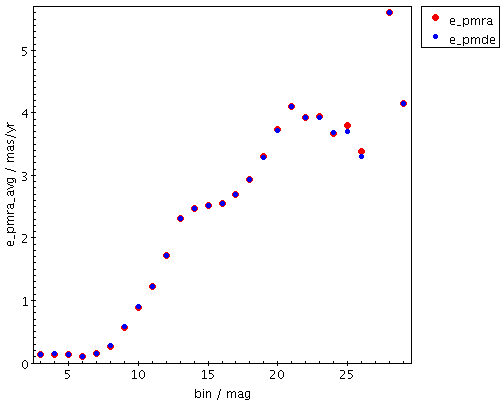
Since the early epochs are missing in USNO-B1 south of -30 degrees (no
early surveys available), the errors in proper motion
are much larger there; here
is the distribution of errors in RA:
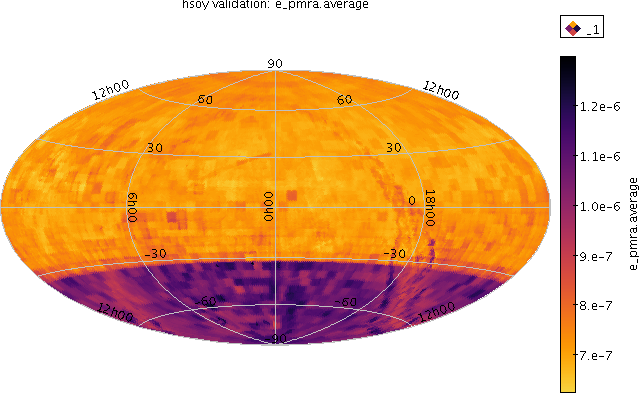
and in Dec:
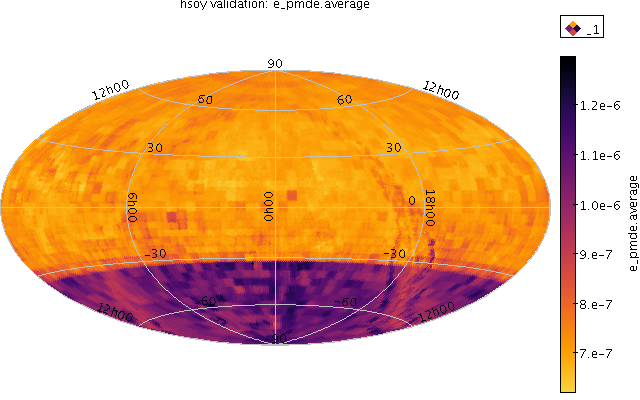
To illustrate HSOY's coverage, this is a plot of the number of objects
per level-6 healpix cell:

Here is a table of minimal, mean, and maximal values of the main HSOY
columns:
| col |
min |
avg |
max |
| raj2000 |
5.684374286825e-07 |
210.993388137 |
359.999993202 |
| dej2000 |
-89.9928427252 |
-9.98338171978 |
89.9901000584 |
| e_raepRA |
4.74927e-09 |
9.14502574957e-07 |
2.38159e-05 |
| e_deepDE |
6.27509e-09 |
7.75452288327e-07 |
2.36765e-05 |
| pmRA |
-0.00216075 |
-4.43904220127e-07 |
0.00242583 |
| pmDE |
-0.00245665 |
-1.09799220875e-06 |
0.00257913 |
| e_pmRA |
1.14448e-08 |
8.34744285904e-07 |
2.68803e-06 |
| e_pmDE |
1.13905e-08 |
8.34238460892e-07 |
2.62362e-06 |
| epRA |
1975.62 |
2014.8336071 |
2015.0 |
| epDE |
1978.95 |
2014.88429072 |
2015.0 |
| Jmag |
-0.676 |
15.1470283958 |
21.749 |
| e_Jmag |
0.013 |
0.0737119978739 |
9.999 |
| Hmag |
-1.739 |
14.5851051481 |
24.292 |
| e_Hmag |
0.0 |
0.0891082665977 |
9.999 |
| Kmag |
-2.099 |
14.3843849985 |
20.532 |
| e_Kmag |
0.0 |
0.102864557141 |
9.999 |
| b1mag |
1.6 |
18.6243196919 |
50.0 |
| b2mag |
0.014 |
18.7001648827 |
65.38 |
| r1mag |
-3.159 |
17.3583684551 |
65.47 |
| r2mag |
0.024 |
17.710484873 |
62.38 |
| imag |
2.171 |
16.704232572 |
64.5 |
| nobs |
3 |
5.5826345577950630 |
17 |
| gaia_id |
65408 |
4045094535853177834 |
6917528993283204480 |
| phot_g_mean_mag |
3.15463 |
17.8191975575 |
28.6129 |
| e_phot_g_mean_mag |
1.06456e-05 |
0.00625220915035 |
0.109 |
G magnitudes and their errors are only given where the flux error as
given in DR1 is smaller than 10% of the flux. In that case, the
flux errors are translated into magnitude errors 1.09*flux_err/flux.
Known Flaws
(1) Duplicates: PPMXL contains many non-matched stars, i.e., two
objects where only one should be present. Where the proper motion
computed for these stars is roughly correct, these non-matched pairs
end up in HSOY as well. All will be matched to the same Gaia DR1
object, which makes them behave rather odd kinematically (they
"collide" at the epoch of Gaia). Such cases are marked with a 1 in
the clone column. Clearly, astrometry has to be used with great
care for these objects.
(2) Conversely, quite a few PPMXL objects match several Gaia DR1
objects. Since the true autocorrelation of Gaia DR1 (and several
following releases) has a sharp drop at 2 arcsec for technical
reasons, these objects do typically not correspond to multiple
star systems but reflect match failures in the construction of Gaia
DR1. In HSOY, such cases are marked with a non-NULL comp (which may
remind you of component; in some rare cases, that association could
actually match reality). This is a
plot of (sum(comp)+sum(clone))/n in level-6
healpix cells, which is a good indicator of the severity of the problems
with (1) and (2). The grid pattern represents the overlap areas in
the surveys that entered into USNO-B, where problem (1) is particularly
severe:
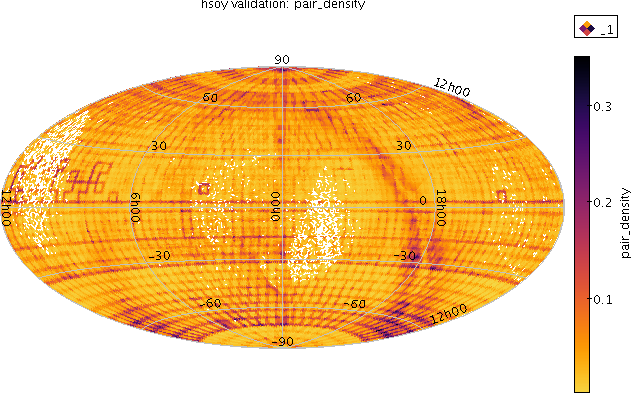
(3) As discussed in 2010AJ....139.2440R, PPMXL inherited
from USNO-B about 2.5e7 spurious objects with high proper motions, mostly
on the edges of plates, where pairs were matched that should not have been
matched. Most of these objects did not hit Gaia DR1 objects when moved to
J2015. Thus, HSOY only contains about 2.5e6 objects faster than 150
mas/yr (2.5e5 on the northern sky). Comparing this with the expectation
of less than 1e5 from 2005AJ....129.1483L in the northern
sky, it is clear
that there still are many spurious high-PM objects in HSOY.
To aid in discarding invalid high-PM objects, we matched
PPMXL with SuperCOSMOS (cf. 2001MNRAS.326.1279H), which an
independent extraction of the plates USNO-B is based on. Objects failing
to match at J2000 received a 1 in HSOY's no_sc column. Note that
for technical reasons, False in no_sc is encoded as NULL.
Therefore, to filter out probably spurious objects,
write WHERE no_sc IS NULL.
This purges another factor of two in bad high-PM objects all-sky
(to 1.4e6). On the northern sky, the result is particularly pronounced,
where only 1.7e5 objects with PM>150 mas/yr are left, well within a factor
of two of the gold standard set by LSPM.
Here are comparisons of the distributions of total proper motions in
HSOY for all (blue) and no_sc IS NULL (red) objects. Top or left
is for the total catalog, bottom or right just the northern sky.
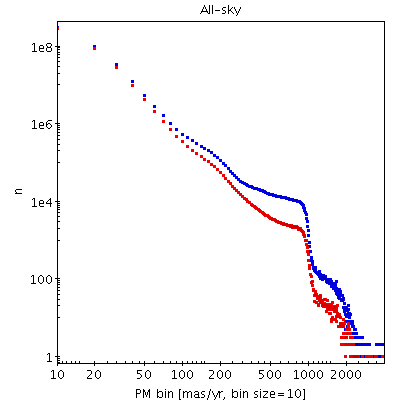
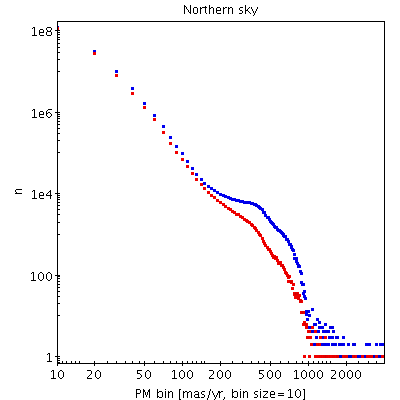
To get an idea of where the obvious problem on the southern sky comes from,
see this density map of stars faster than 150 mas/yr in HEALPixes of order
6, plotted in galactic coordinates. Only objects for which all of no_sc,
comp, and clone are NULL are shown. Note that the scale on the aux axis is
logarithmic:
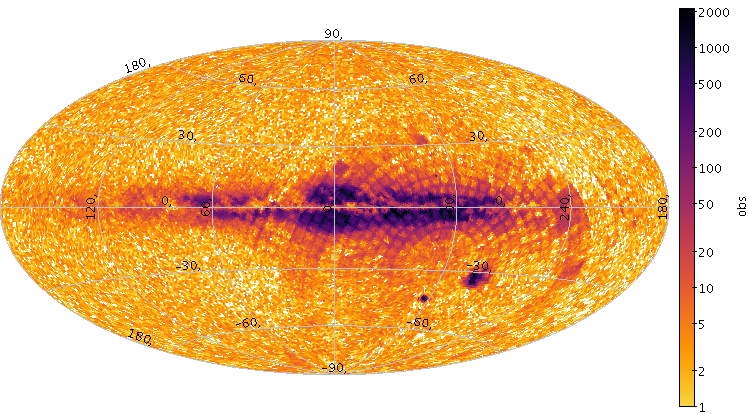
Essentially, in areas so crowded that almost any movement of a star will
hit another (within our match criteria) there will be many spurious
high-pm stars, in particular when there are many spurious sources to begin
with (plate borders). In sufficient distance from the bulge and the
Magellanic clouds, high proper motions in HSOY should be fairly reliable
when filtering out the suspicious (no_sc, clone, comp) objects.
(4) HSOY inherits the USNO photometry in B, R, and I. It has many known
issues (including, but not limited to, ridiculous values like 65.47
shown in the table above). Do not lightly use b1mag, b2mag, r1mag, r2mag,
and imag, as many of them are invalid.
(5) At the bright end, HSOY is severely incomplete. This reflects
the corresponding incompleteness of Gaia DR1.
Trivia
The primary key of HSOY is the tuple (ipix,comp). The suggested reference
to a HSOY object is "HSOY <ipix>.0" when comp is NULL, and "HSOY
<ipix>.<comp>" otherwise.
If you want to cite HSOY, please see our citation advice.
Overview
You can access this service using:
-
form --
an interface for web browsers through an HTML form
Coverage

Intervals of messenger energies reflected in this resource: 0.51661 3.35107 eV
Time covered by this resource's data: 2000 2000
This resource is not (directly) published.
This can mean that it was deemed too unimportant, for internal
use only, or is just a helper for a published service.
Equally likely, however,
it is under development, abandoned in development or otherwise
unfinished. Exercise some caution.
Other services provided on the underlying data
include:
Copyright, License, Acknowledgements
Citation Info
VOResource XML (that's something exclusively for VO nerds)
![[CC0]](/static/img/cc0.png)
![[Operator logo]](/static/img/logo_medium.png)
![[Use this service from your browser]](/static/img/usesvcbutton.png)







